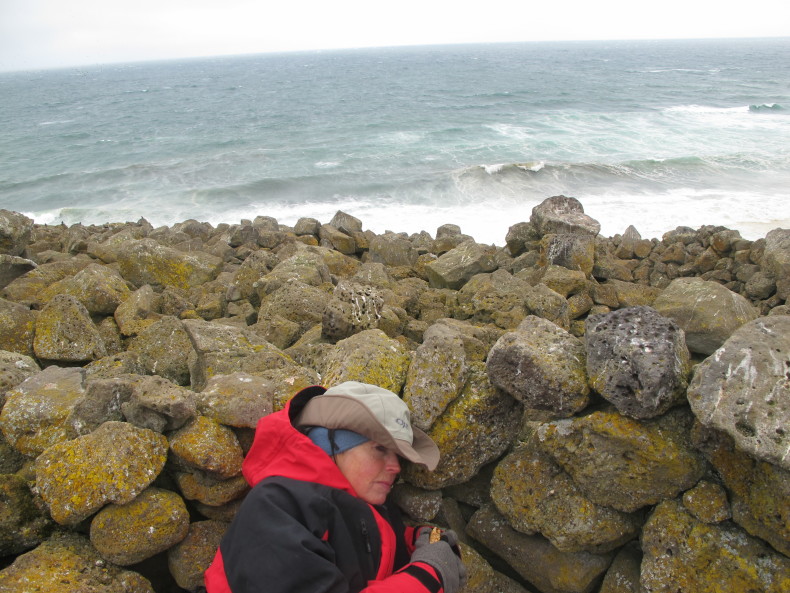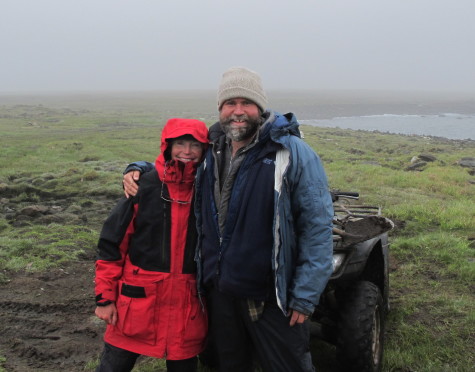 All this week Last Word on Nothing is geared toward Mother’s Day, which is next Sunday. Tell your mother you love her and share some of our posts, things are about to get maternal.
All this week Last Word on Nothing is geared toward Mother’s Day, which is next Sunday. Tell your mother you love her and share some of our posts, things are about to get maternal.
Pictured above: my mother.
I held her cold hands in mine, rubbing warmth into them as she crouched behind a rock stack. A wet, July wind was blowing in off the Bering Sea and we’d taken shelter in a hunting blind on a treeless cape of St. Lawrence Island, Alaska. A couple weeks before this trip, I’d asked her if she wanted to come with me to an island 3 degrees below the Arctic circle between the coasts of Siberia and Western Alaska. Without hesitation, she’d said yes. I told her I didn’t know where we were going to stay, landing in a Yup’ik subsistence village with no infrastructure for travelers. She still said yes, not a pause to think about it.
This is what is like to be a science writer’s mom, and to be an adventurer’s son.
A scrappy, short animal of a woman, my mom is missing half of two fingers on one hand and a small portion of a third. It was a table saw accident. She used to make a living building furniture, sometimes working too late at night. I rubbed her bony, rough hands just like I did when I was a kid and we’d be on the snowbound side of a mountain in a howling wind, tears welling in her eyes from how cold her fingers would get.
I’d come to St. Lawrence Island to talk to people about the effects of changing Arctic climates and rises in sea level, and I was also curious about it being one of the last standing remnants of the Bering land bridge. I wanted to put my two feet on this legendary piece of earth. My mom just wanted the sun to come back. She was born three months premature in the small West Texas town of Alpine and was kept alive in a chicken incubator. The way she loves the sun so much, her eyes closing and face titling up almost involuntarily on warm days, I’ve wondered if it was a memory of that light bulb in the incubator, a source of warmth and comfort in her earliest days.
She and I became a brief fixture in the village, put up in the wood-panel town meeting hall where we used the microwave to heat ramen. Women would come by bringing baked goods as gifts, sitting for hours and talking. I have to admit, in the back of my head I had a strategy for bringing her here. Yup’ik society is matrilineal. I thought people might be more open to me if my mother was along, and over 60 she was automatically considered an elder. She ended up being a handful, reprimanding the old men for smoking until they hid their cigarettes whenever she came by.
We spent our days walking through gusting sleet and banks of clear northern sunlight. I was trying to get a sense of this treeless Pleistocene landscape, imagining that people must have once used the mountainous interior of the island as a landmark, a beacon. Halfway across the land bridge it was the only real topography, at the time 500 miles from the nearest coastline, now standing in the middle of a skinny bean of an island 90 miles from tip to tip.
We went out with hunter on a foggy afternoon. I’d borrowed a four-wheeler in the village and my mom rode on the back clutched to me as we followed him across tundra along the island’s north-central coast. I wasn’t particularly used to four-wheelers and there was no actual road or trail. We gunned in and out of gullies, tires grabbing at slicks of bog grass. Whenever we hit a dip and I rammed the accelerator to get up the other side, she unleashed a guttural, involuntary sound directly into my hear.
“Stop it!” I shouted. I was trying to concentrate, still having trouble with gears and the accelerator.
“Well, slow down!” she shouted back.
“Can you just stop shouting in my ear?”
“I can’t help it!”
Motoring through streamers of fog, losing and regaining the hunter driving ahead of us, I believed that we were playing out an ancient scene. This was how some of the first people must have come across the Bering land bridge. Before us spread a green and rolling expanse, more or less what the land bridge would have looked like in its day. A man might have been moving across the tundra steppe with his mother riding his back. Her bony finger would have pointed over his shoulder warning of every gully and mammoth ahead. Her voice would have rang out in his ear, Watch out! Be careful!
Every year, my mom goes to Chilean Patagonia for a foot trek, crossing rivers by holding her pack on her head, or being carried on the back of one of her stronger teammates. She spends more nights a year sleeping out than I do, happiest when she is not indoors, especially when the sun shines on her face like the warm light of an incubator. She is probably the reason people crossed the land bridge in the first place. Restless, adventurous, willing to go almost anywhere even if she gripped me tighter and tighter, every big bump unleashing sounds from her diaphragm as we bounced our way across what was once the Bering land bridge.
Photos: Craig Childs
